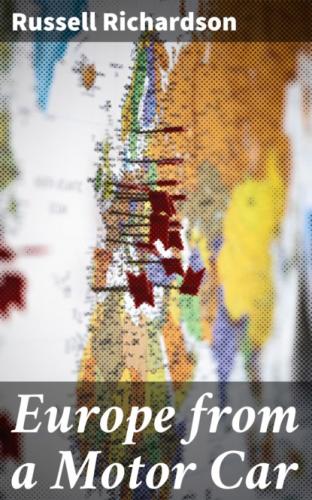Russell Richardson
Europe from a Motor Car
Published by Good Press, 2021
EAN 4064066140083
Table of Contents
CHAPTER II MARIENBAD TO TRAFOI
CHAPTER III CROSSING THE STELVIO INTO ITALY
CHAPTER VI NÎMES TO CARCASSONNE
CHAPTER VII CARCASSONNE TO TARBES
CHAPTER VIII TARBES TO BIARRITZ
CHAPTER X BIARRITZ TO MONT-DE-MARSAN
CHAPTER XI MONT-DE-MARSAN TO PÉRIGUEUX
CHAPTER XII PÉRIGUEUX TO TOURS
CHAPTER XIII THE CHÂTEAUX OF TOURAINE
CHAPTER XV EXPENSES AND SUGGESTIONS
PREFACE
The following pages have not been written to supplement the thousands of guide books about Europe. Long, technical descriptions have been avoided. An endeavor has been made, rather, to give our personal impressions of the Old World from a motor car. Our itinerary overlooked the larger cities whose contents have been so well inventoried by Baedeker. The life of the peasantry, the small towns seldom visited by American tourists, quaint villages unapproached by any railroad, the superb roads and views of the Tyrol, the crossing of the Alps over the snow-crowned Stelvio into Italy, the flight through northern Italy to Como, loveliest of the Italian lakes—such unique experiences amid beautiful scenery appealed to us more than the attractions of the crowded metropolis. We were out for a motor ramble instead of a sight-seeing tour. Our route did not follow entirely the familiar highways of tourist traffic. From the summit of the Alps we were to see, far below us, the valleys of picturesque Savoy. Then came the long, thrilling descent into France through Provençe, that treasure land of Roman antiquity, through the Pyrenees, lifting their huge barriers between France and Spain, to Biarritz on the Atlantic. Spain was before us, the pastoral beauties of Limousin and Périgord, the châteaux of Touraine, and the cathedrals of Normandy.
An important part of our equipment was the Michelin Guide, which, with its convenient arrangement and wealth of useful information about hotels and roads, rendered invaluable aid. Its maps were so clear that it was seldom necessary to retrace our path. By means of them we planned our route and found our way through the different countries.
The writer wishes to thank Michelin & Co. of Paris, and Dr. Lehmann of the Benz Company in Mannheim, Germany, for their assistance and advice. The files of the London Daily Mail contributed helpful suggestions. Obligation is also expressed to Mr. Charles Netcher, whose good judgment and motormanship were indispensable to the success of the trip.
Russell Richardson.
A French highway Page 178
EUROPE FROM A MOTOR CAR
CHAPTER I
BERLIN TO MARIENBAD
Before us was the long stretch of the Potsdamer Strasse bathed in the sunshine of a July morning. Slowly the speedometer began to devour the kilometers of the Kaiser's imperial city, and the low music of the siren seemed like a song of rejoicing that we were at last starting on our quest of motor experiences along the highways of Europe. The exhilaration of the moment called for speed, a leaping burst of it, but a Berlin street is unfortunately no place for speeding. Numerous helmeted policemen, vigilant guardians of German speed laws, were sufficient reminders that the way of the motor transgressor would be paved with heavy fines.
These policemen looked like soldiers. In Berlin one is always surrounded by a military atmosphere. The city is the product and the producer of this martial spirit. The Prussian wars are written so completely in pages of bronze and marble, one has the impression of being among people who are on the verge of war and prepared for it. Even as we glided along, a huge Zeppelin air ship hovered above us, one of those ill-fated war machines which have so often met destruction.
A little farther on, there was a stirring sound of military music, and our way was intercepted by a marching regiment. It was fully ten minutes before the last soldier passed. Such scenes are common in the capital of a country bounded on two frontiers by powerful nations, and dependent for its very existence upon the maintenance of a large standing army.
Gradually the music grew fainter, the warnings of countless "verbotens" became less frequent. Soon we were riding through the Prussian country, pleasantly pastoral and interspersed by red-roofed villages. Everywhere were barracks and soldiers, and each small community was throbbing with industrial life. This was prosaic, military, modern Germany; that is, it might have seemed prosaic had we not seen it from a motor car. There is a quality of romance about all motoring in Europe. It is fascinating to appear unexpectedly among a people in the midst of their everyday activities, to see them as they really are, to flash for a brief moment upon the horizon of their local life, and then to whirl on to other scenes. Such a trip is never monotonous. There is magic in this song of the swift kilometers.
The tourist, by train or on foot, is overwhelmed by details. He sees small cross-sections of life. But the motorist, of all travelers, can see larger outlines. For him a thousand details merge to form a unit which he can grasp; to paint a picture of clear-cut, dominating impressions and filled with life-long memories. Even "the best traveler[1] on foot—Barrow or Stevenson—can enjoy himself, or interest others, only by his
